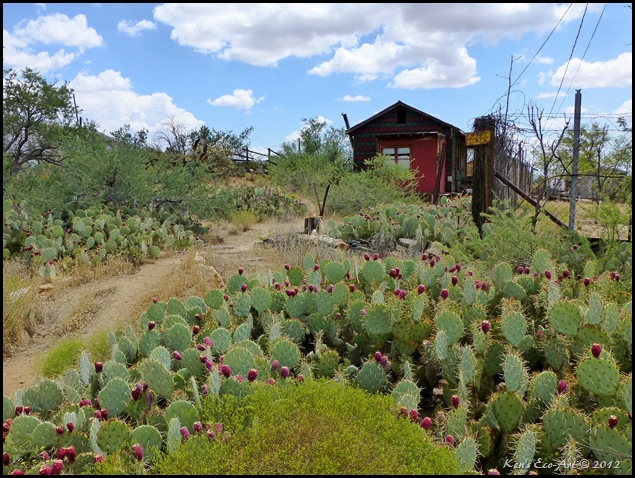Picture Notes: The Prickly Pear Cactus can be a thing of beauty. It appears that their color depends upon the time of year and the amount of rainfall the area has received. The picture in (Fig. 01) was shot on 06/18/2013 while hiking in the Spring Mountains, west of Wheeler Pass. Click here for more info on the area ... Side Trips Along Wheeler Pass Road. The picture in (Fig. 02) was captured on 02/14/2011 while hiking in the Wee Thump Joshua Tree Wilderness Area along the Joshua Tree Highway, just west of Searchlight, NV. Click here to visit or go back to the Wee Thumb Joshua Tree Wilderness page … Wee Thump Joshua Tree Wilderness Area.
On 08/21/2012, during a visit to Chloride, AZ, I was driving around the northern outskirts of town looking for its old jailhouse, when I found a private yard (Fig. 03) chocked full of Prickly Pear Cactus. I can honestly say that I have never seen such a large grouping of these cacti growing in one spot ever before. The close-up shot in (Fig. 04) shows off their many highly prized blushing fruit pods, sometimes called Indian Fig, but known in the Spanish-speaking Southwest as tuna – highly priced, one 3-ounce fig can go for as much as a $1.50. If you try to ‘harvest’ one of these figs, beware of the small, hair-like prickles called glochids, that easily detach from the plant and penetrate skin, causing much irritation and pain. Click here to visit the page on Chloride, Arizona … Chloride Arizona.
|
 |
| (Fig. 02) |
|
 |
| (Fig. 03) |
|
Description: Prickly Pear Cactus (Opuntia phaeacantha), a.k.a. the Tulip Prickly Pear and Desert Prickly Pear. Older names for this species, and names for old species which are now considered variants of this species, include Plateau Prickly Pear, Brown-spined Prickly Pear, Mojave Prickly Pear, and Kingman Prickly Pear. Though there are many different species of prickly pear cacti, the Opuntia phaeacantha is one of the most common species of prickly pear cactus. It is found all across the southwestern United States and northern Mexico.
Prickly pears typically grow with flat, fleshy pads that look like large leaves. These rounded platyclades are armed with two kinds of spines; large, smooth, fixed spines and small, hair-like prickles called glochids, that easily penetrate skin and detach from the plant. The pads are actually modified branches or stems that serve several functions -- water storage, photosynthesis and flower production. Many types of prickly pears grow into dense, tangled structures. Like all true cactus species, prickly pears are native only to the Western hemisphere. Prickly pear species, found in abundance in Mexico, are also found in the mid and lower elevations of the southwestern regions of the United States. the Rocky Mountains such as in Colorado, where species such as Opuntia phaeacantha, Opuntia polyacantha and others become dominant, and especially in the desert Southwest.
There has been medical interest in the Prickly Pear plant. Some studies have shown that the pectin contained in the Prickly Pear pulp lowers levels of "bad" cholesterol while leaving "good" cholesterol levels unchanged. Another study found that the fibrous pectin in the fruit may lower a diabetics' need for insulin. Both fruits and pads of the prickly pear cactus are rich in slowly absorbed soluble fibers that help keep blood sugar stable. Prickly Pear Nectar is made with the juice and pulp of the fruits.
|
|